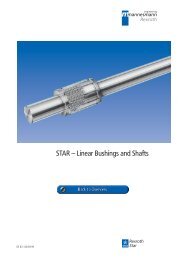STAR – Precision Ball Screw Assemblies
STAR – Precision Ball Screw Assemblies
STAR – Precision Ball Screw Assemblies
You also want an ePaper? Increase the reach of your titles
YUMPU automatically turns print PDFs into web optimized ePapers that Google loves.
<strong>STAR</strong> <strong>–</strong> <strong>Precision</strong> <strong>Ball</strong> <strong>Screw</strong> <strong>Assemblies</strong><br />
Mounting<br />
Nut mounting, general<br />
<strong>–</strong> preloaded single nut<br />
<strong>–</strong> double nut<br />
These models are supplied with<br />
premounted nut units. The nut unit and<br />
screw may not be disassembled. Should<br />
this become necessary for any reason,<br />
please ask.<br />
<strong>–</strong> single nut with reduced backlash<br />
<strong>–</strong> adjustable preload single nut<br />
The nut unit may only be mounted using a<br />
mounting arbor. The outer diameter of the<br />
arbor should be approx. 0.1 mm smaller<br />
than the root diameter of the screw. In<br />
most cases, the transport arbor on which<br />
the nuts are delivered may be used to<br />
mount the nut. The end of the screw<br />
thread must be chamfered in order to<br />
prevent damage to the seal and the<br />
internal components of the nut unit.<br />
The various mounting steps are described<br />
below.<br />
Proceed in reverse order when removing<br />
the nut from the screw. Take particular<br />
care not to damage the nut, screw or<br />
internal components, as this could result in<br />
the premature failure of the ball screw<br />
assembly.<br />
Mounting instructions are supplied as<br />
standard along with every unit.<br />
Mounting steps<br />
The nut is to be mounted as follows:<br />
Remove the rubber ring from one end of<br />
the mounting arbor.<br />
Push the mounting arbor with nut until it<br />
engages with the end of the thread.<br />
The arbor must make contact with axial<br />
clearance.<br />
Carefully turn the nut unit onto the thread,<br />
applying only light axial pressure.<br />
<strong>–</strong> Setting the radial clearance or<br />
preload of adjustable-preload<br />
single nuts<br />
Measurement of the dynamic drag torque<br />
for SEM-E-C and SEM-E-S..<br />
Using the adjusting screw, reduce the<br />
clearance of the nut mounted on the<br />
screw until the corresponding dynamic<br />
drag torque Tpr0 specified in the table<br />
! page 87, has been attained (ball<br />
screw lightly oiled).<br />
Check this torque along the entire length<br />
of the thread; if the torque deviates from<br />
the value specified in the table at any<br />
point along the thread, adjust accordingly.<br />
Once the torque has been properly<br />
adjusted, the centering diameter D1 must<br />
correspond to the values specified in the<br />
table ! page 87. Cover the head of the<br />
screw with a protective cap.<br />
F<br />
Measuring gauge e.g.<br />
spring gauge<br />
T = F·r<br />
T pra = currently measured dynamic drag<br />
torque<br />
90 RE 83 301/12.99<br />
D 1<br />
r<br />
pra<br />
Adjusting<br />
screw



